Brand Management Report: BTEC Level 5 - Brand Management - Lidl GB
VerifiedAdded on 2022/12/28
|21
|5097
|178
Report
AI Summary
This report provides a comprehensive analysis of brand management, focusing on the case of Lidl GB, a supermarket chain in the UK. It begins by exploring the significance of branding as a marketing tool, detailing its emergence in business practices and its importance in building brand recognition, enhancing business value, increasing market share, and building customer trust. The report then delves into the components of a successful brand strategy, including brand purpose, vision, value, and market analysis, providing examples such as Walmart. It discusses strategies for portfolio management, brand equity, and brand hierarchy, including models like House of Brands and Branded House. The report also examines how brands are managed over time using models like the 360-degree brand management process and the CBBE model. It further assesses how brands are administered collaboratively and in partnership, both at a home and global level, and evaluates various tools for handling brand value. The report aims to provide a comprehensive understanding of branding principles and their practical application within the context of a real-world organization.
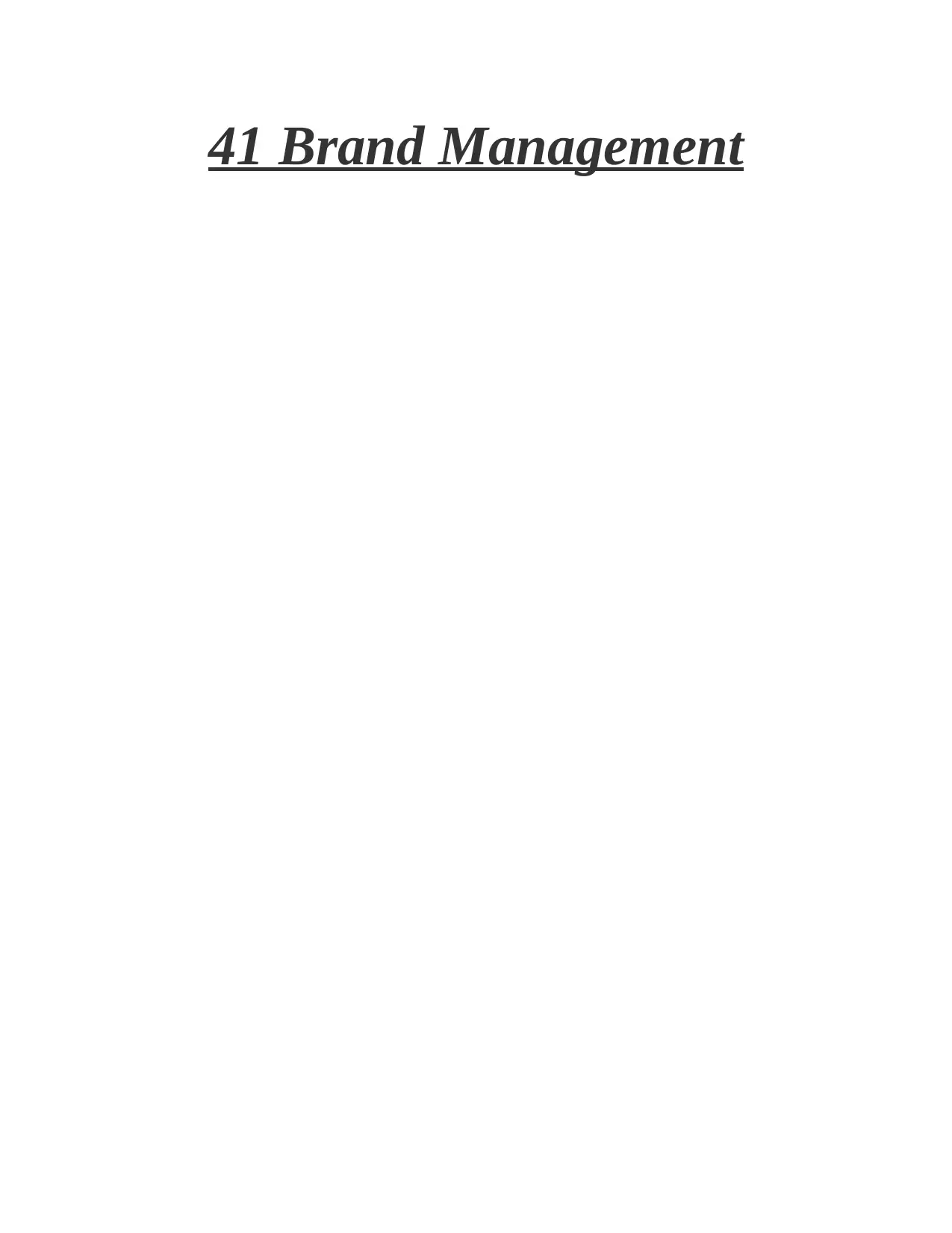
41 Brand Management
Paraphrase This Document
Need a fresh take? Get an instant paraphrase of this document with our AI Paraphraser
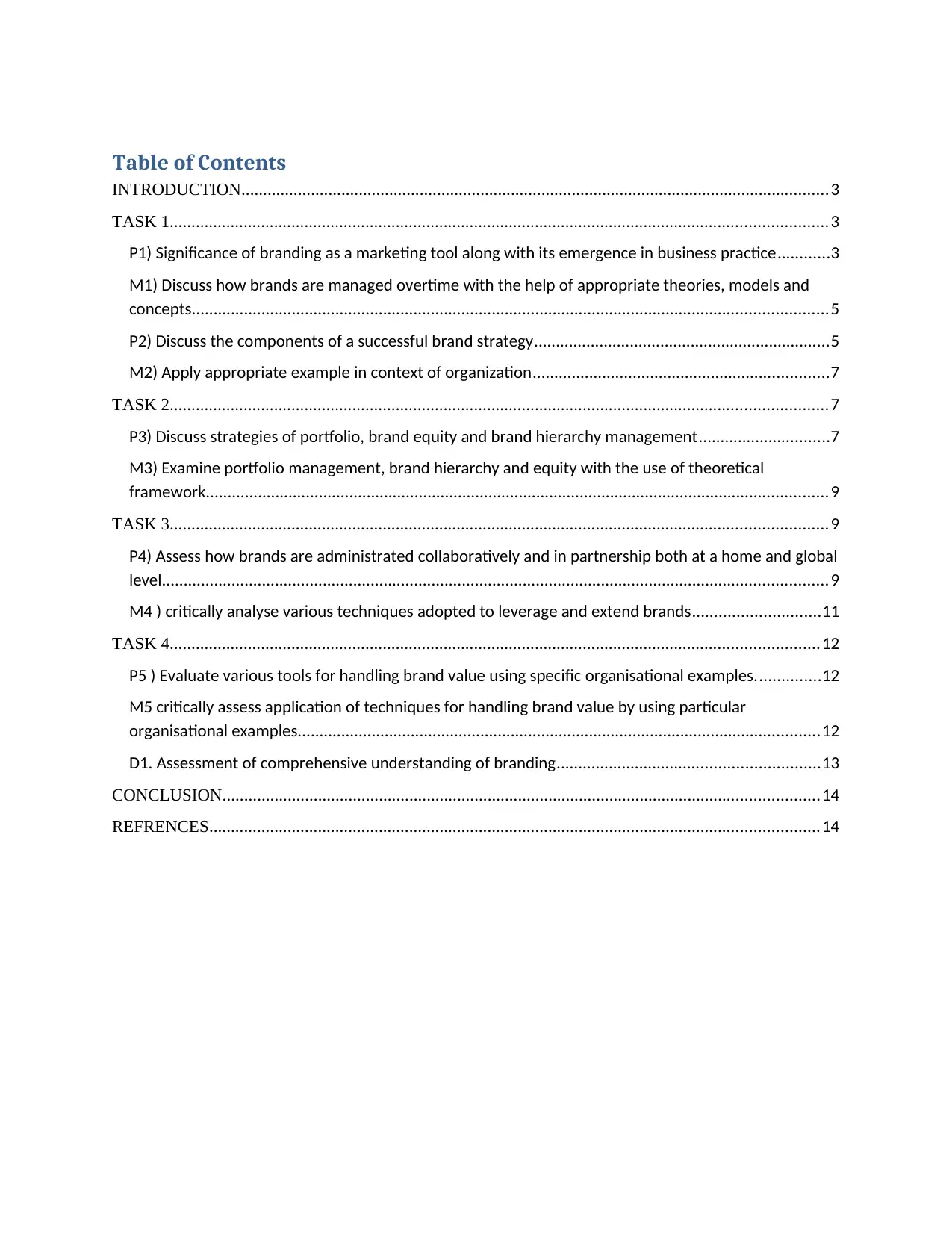
Table of Contents
INTRODUCTION.......................................................................................................................................3
TASK 1.......................................................................................................................................................3
P1) Significance of branding as a marketing tool along with its emergence in business practice............3
M1) Discuss how brands are managed overtime with the help of appropriate theories, models and
concepts..................................................................................................................................................5
P2) Discuss the components of a successful brand strategy....................................................................5
M2) Apply appropriate example in context of organization....................................................................7
TASK 2.......................................................................................................................................................7
P3) Discuss strategies of portfolio, brand equity and brand hierarchy management..............................7
M3) Examine portfolio management, brand hierarchy and equity with the use of theoretical
framework...............................................................................................................................................9
TASK 3.......................................................................................................................................................9
P4) Assess how brands are administrated collaboratively and in partnership both at a home and global
level.........................................................................................................................................................9
M4 ) critically analyse various techniques adopted to leverage and extend brands.............................11
TASK 4.....................................................................................................................................................12
P5 ) Evaluate various tools for handling brand value using specific organisational examples...............12
M5 critically assess application of techniques for handling brand value by using particular
organisational examples........................................................................................................................12
D1. Assessment of comprehensive understanding of branding............................................................13
CONCLUSION.........................................................................................................................................14
REFRENCES............................................................................................................................................14
INTRODUCTION.......................................................................................................................................3
TASK 1.......................................................................................................................................................3
P1) Significance of branding as a marketing tool along with its emergence in business practice............3
M1) Discuss how brands are managed overtime with the help of appropriate theories, models and
concepts..................................................................................................................................................5
P2) Discuss the components of a successful brand strategy....................................................................5
M2) Apply appropriate example in context of organization....................................................................7
TASK 2.......................................................................................................................................................7
P3) Discuss strategies of portfolio, brand equity and brand hierarchy management..............................7
M3) Examine portfolio management, brand hierarchy and equity with the use of theoretical
framework...............................................................................................................................................9
TASK 3.......................................................................................................................................................9
P4) Assess how brands are administrated collaboratively and in partnership both at a home and global
level.........................................................................................................................................................9
M4 ) critically analyse various techniques adopted to leverage and extend brands.............................11
TASK 4.....................................................................................................................................................12
P5 ) Evaluate various tools for handling brand value using specific organisational examples...............12
M5 critically assess application of techniques for handling brand value by using particular
organisational examples........................................................................................................................12
D1. Assessment of comprehensive understanding of branding............................................................13
CONCLUSION.........................................................................................................................................14
REFRENCES............................................................................................................................................14
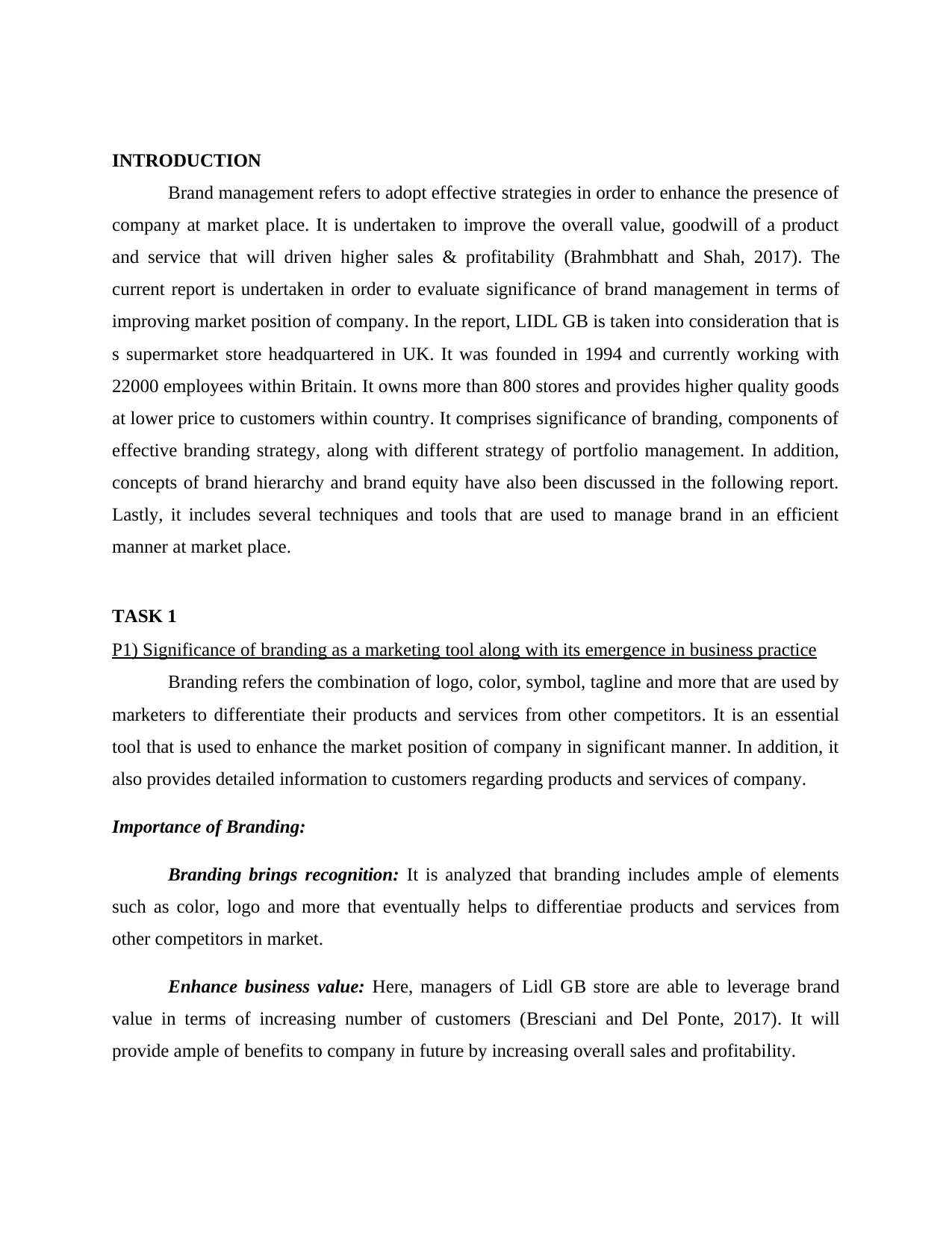
INTRODUCTION
Brand management refers to adopt effective strategies in order to enhance the presence of
company at market place. It is undertaken to improve the overall value, goodwill of a product
and service that will driven higher sales & profitability (Brahmbhatt and Shah, 2017). The
current report is undertaken in order to evaluate significance of brand management in terms of
improving market position of company. In the report, LIDL GB is taken into consideration that is
s supermarket store headquartered in UK. It was founded in 1994 and currently working with
22000 employees within Britain. It owns more than 800 stores and provides higher quality goods
at lower price to customers within country. It comprises significance of branding, components of
effective branding strategy, along with different strategy of portfolio management. In addition,
concepts of brand hierarchy and brand equity have also been discussed in the following report.
Lastly, it includes several techniques and tools that are used to manage brand in an efficient
manner at market place.
TASK 1
P1) Significance of branding as a marketing tool along with its emergence in business practice
Branding refers the combination of logo, color, symbol, tagline and more that are used by
marketers to differentiate their products and services from other competitors. It is an essential
tool that is used to enhance the market position of company in significant manner. In addition, it
also provides detailed information to customers regarding products and services of company.
Importance of Branding:
Branding brings recognition: It is analyzed that branding includes ample of elements
such as color, logo and more that eventually helps to differentiae products and services from
other competitors in market.
Enhance business value: Here, managers of Lidl GB store are able to leverage brand
value in terms of increasing number of customers (Bresciani and Del Ponte, 2017). It will
provide ample of benefits to company in future by increasing overall sales and profitability.
Brand management refers to adopt effective strategies in order to enhance the presence of
company at market place. It is undertaken to improve the overall value, goodwill of a product
and service that will driven higher sales & profitability (Brahmbhatt and Shah, 2017). The
current report is undertaken in order to evaluate significance of brand management in terms of
improving market position of company. In the report, LIDL GB is taken into consideration that is
s supermarket store headquartered in UK. It was founded in 1994 and currently working with
22000 employees within Britain. It owns more than 800 stores and provides higher quality goods
at lower price to customers within country. It comprises significance of branding, components of
effective branding strategy, along with different strategy of portfolio management. In addition,
concepts of brand hierarchy and brand equity have also been discussed in the following report.
Lastly, it includes several techniques and tools that are used to manage brand in an efficient
manner at market place.
TASK 1
P1) Significance of branding as a marketing tool along with its emergence in business practice
Branding refers the combination of logo, color, symbol, tagline and more that are used by
marketers to differentiate their products and services from other competitors. It is an essential
tool that is used to enhance the market position of company in significant manner. In addition, it
also provides detailed information to customers regarding products and services of company.
Importance of Branding:
Branding brings recognition: It is analyzed that branding includes ample of elements
such as color, logo and more that eventually helps to differentiae products and services from
other competitors in market.
Enhance business value: Here, managers of Lidl GB store are able to leverage brand
value in terms of increasing number of customers (Bresciani and Del Ponte, 2017). It will
provide ample of benefits to company in future by increasing overall sales and profitability.
⊘ This is a preview!⊘
Do you want full access?
Subscribe today to unlock all pages.

Trusted by 1+ million students worldwide
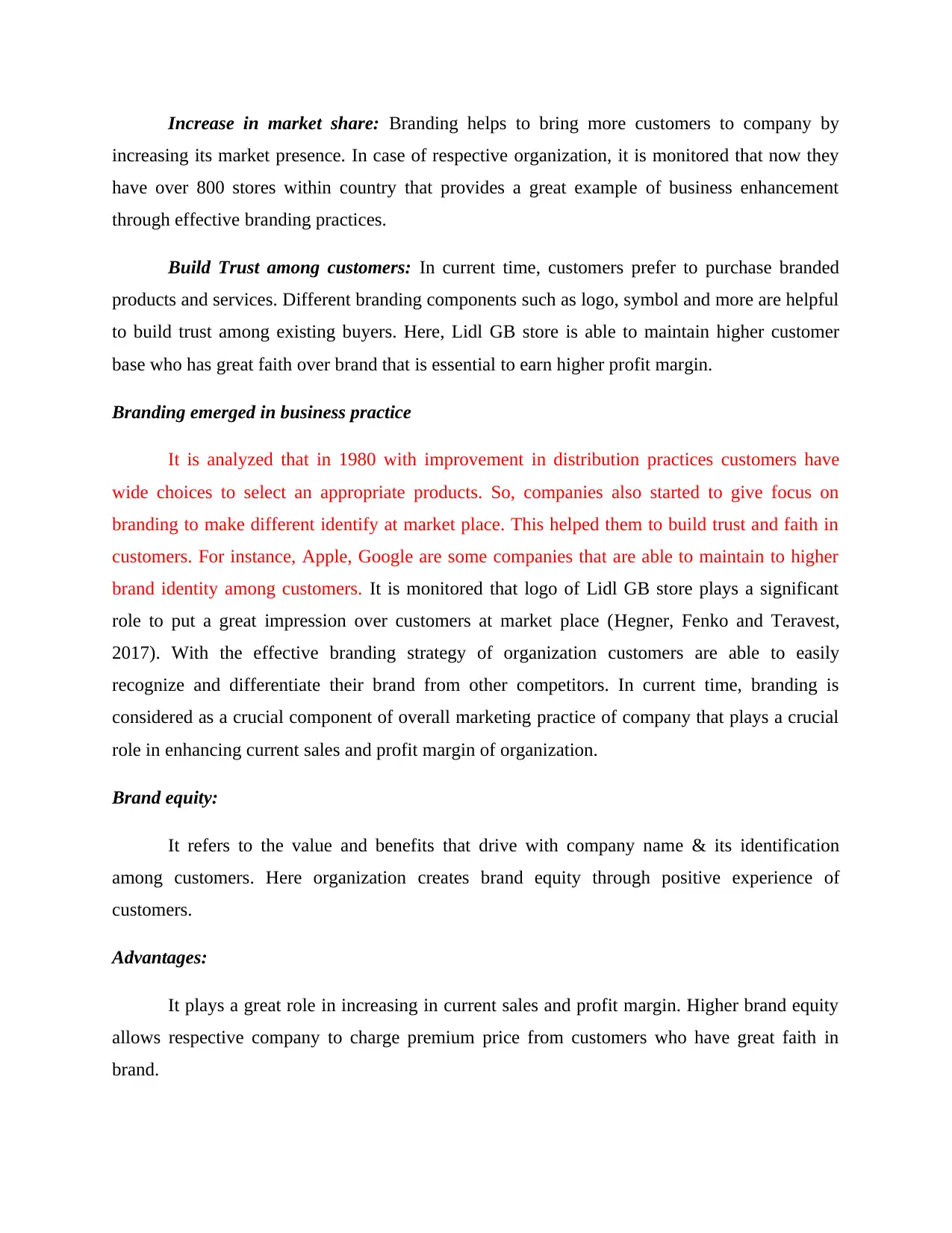
Increase in market share: Branding helps to bring more customers to company by
increasing its market presence. In case of respective organization, it is monitored that now they
have over 800 stores within country that provides a great example of business enhancement
through effective branding practices.
Build Trust among customers: In current time, customers prefer to purchase branded
products and services. Different branding components such as logo, symbol and more are helpful
to build trust among existing buyers. Here, Lidl GB store is able to maintain higher customer
base who has great faith over brand that is essential to earn higher profit margin.
Branding emerged in business practice
It is analyzed that in 1980 with improvement in distribution practices customers have
wide choices to select an appropriate products. So, companies also started to give focus on
branding to make different identify at market place. This helped them to build trust and faith in
customers. For instance, Apple, Google are some companies that are able to maintain to higher
brand identity among customers. It is monitored that logo of Lidl GB store plays a significant
role to put a great impression over customers at market place (Hegner, Fenko and Teravest,
2017). With the effective branding strategy of organization customers are able to easily
recognize and differentiate their brand from other competitors. In current time, branding is
considered as a crucial component of overall marketing practice of company that plays a crucial
role in enhancing current sales and profit margin of organization.
Brand equity:
It refers to the value and benefits that drive with company name & its identification
among customers. Here organization creates brand equity through positive experience of
customers.
Advantages:
It plays a great role in increasing in current sales and profit margin. Higher brand equity
allows respective company to charge premium price from customers who have great faith in
brand.
increasing its market presence. In case of respective organization, it is monitored that now they
have over 800 stores within country that provides a great example of business enhancement
through effective branding practices.
Build Trust among customers: In current time, customers prefer to purchase branded
products and services. Different branding components such as logo, symbol and more are helpful
to build trust among existing buyers. Here, Lidl GB store is able to maintain higher customer
base who has great faith over brand that is essential to earn higher profit margin.
Branding emerged in business practice
It is analyzed that in 1980 with improvement in distribution practices customers have
wide choices to select an appropriate products. So, companies also started to give focus on
branding to make different identify at market place. This helped them to build trust and faith in
customers. For instance, Apple, Google are some companies that are able to maintain to higher
brand identity among customers. It is monitored that logo of Lidl GB store plays a significant
role to put a great impression over customers at market place (Hegner, Fenko and Teravest,
2017). With the effective branding strategy of organization customers are able to easily
recognize and differentiate their brand from other competitors. In current time, branding is
considered as a crucial component of overall marketing practice of company that plays a crucial
role in enhancing current sales and profit margin of organization.
Brand equity:
It refers to the value and benefits that drive with company name & its identification
among customers. Here organization creates brand equity through positive experience of
customers.
Advantages:
It plays a great role in increasing in current sales and profit margin. Higher brand equity
allows respective company to charge premium price from customers who have great faith in
brand.
Paraphrase This Document
Need a fresh take? Get an instant paraphrase of this document with our AI Paraphraser
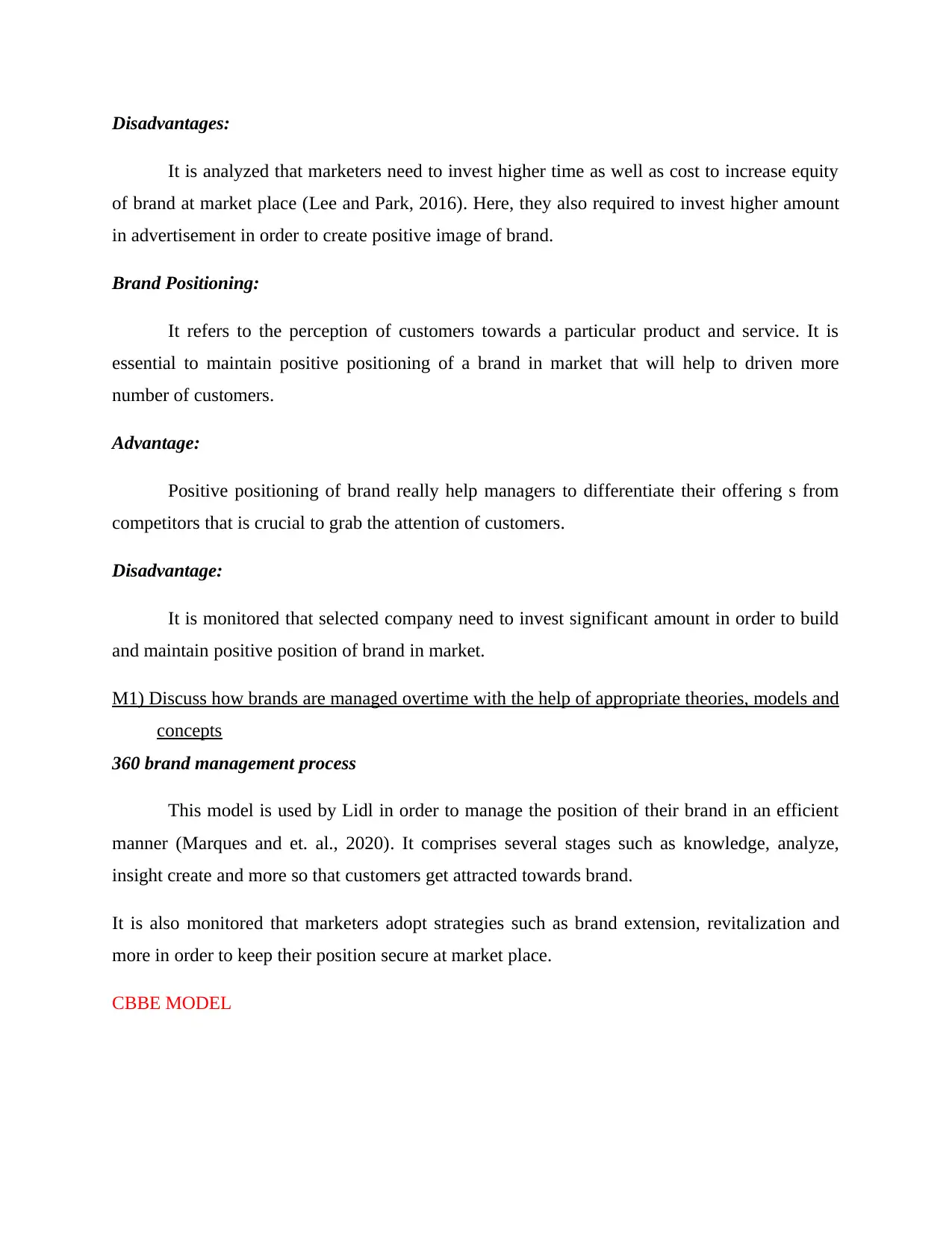
Disadvantages:
It is analyzed that marketers need to invest higher time as well as cost to increase equity
of brand at market place (Lee and Park, 2016). Here, they also required to invest higher amount
in advertisement in order to create positive image of brand.
Brand Positioning:
It refers to the perception of customers towards a particular product and service. It is
essential to maintain positive positioning of a brand in market that will help to driven more
number of customers.
Advantage:
Positive positioning of brand really help managers to differentiate their offering s from
competitors that is crucial to grab the attention of customers.
Disadvantage:
It is monitored that selected company need to invest significant amount in order to build
and maintain positive position of brand in market.
M1) Discuss how brands are managed overtime with the help of appropriate theories, models and
concepts
360 brand management process
This model is used by Lidl in order to manage the position of their brand in an efficient
manner (Marques and et. al., 2020). It comprises several stages such as knowledge, analyze,
insight create and more so that customers get attracted towards brand.
It is also monitored that marketers adopt strategies such as brand extension, revitalization and
more in order to keep their position secure at market place.
CBBE MODEL
It is analyzed that marketers need to invest higher time as well as cost to increase equity
of brand at market place (Lee and Park, 2016). Here, they also required to invest higher amount
in advertisement in order to create positive image of brand.
Brand Positioning:
It refers to the perception of customers towards a particular product and service. It is
essential to maintain positive positioning of a brand in market that will help to driven more
number of customers.
Advantage:
Positive positioning of brand really help managers to differentiate their offering s from
competitors that is crucial to grab the attention of customers.
Disadvantage:
It is monitored that selected company need to invest significant amount in order to build
and maintain positive position of brand in market.
M1) Discuss how brands are managed overtime with the help of appropriate theories, models and
concepts
360 brand management process
This model is used by Lidl in order to manage the position of their brand in an efficient
manner (Marques and et. al., 2020). It comprises several stages such as knowledge, analyze,
insight create and more so that customers get attracted towards brand.
It is also monitored that marketers adopt strategies such as brand extension, revitalization and
more in order to keep their position secure at market place.
CBBE MODEL
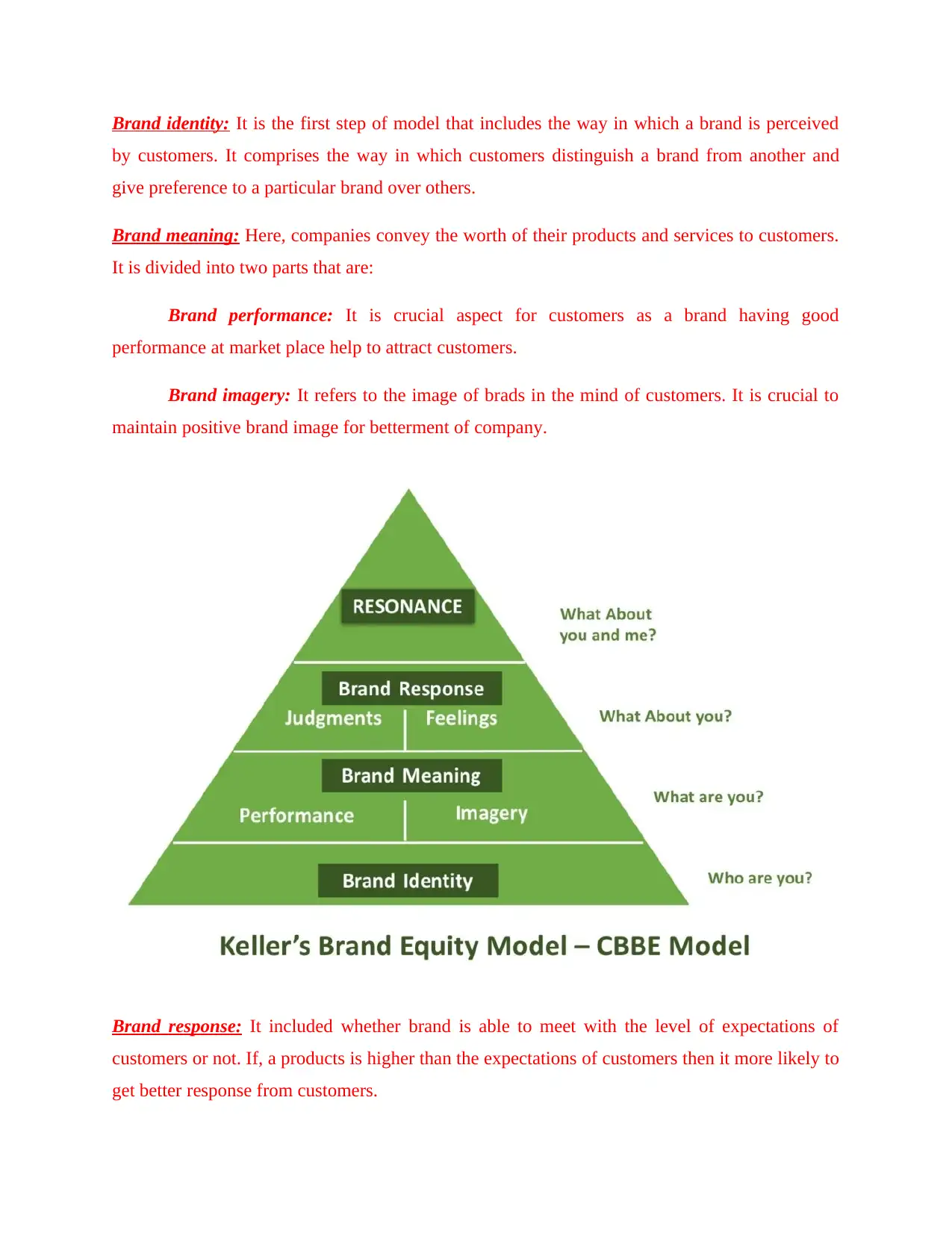
Brand identity: It is the first step of model that includes the way in which a brand is perceived
by customers. It comprises the way in which customers distinguish a brand from another and
give preference to a particular brand over others.
Brand meaning: Here, companies convey the worth of their products and services to customers.
It is divided into two parts that are:
Brand performance: It is crucial aspect for customers as a brand having good
performance at market place help to attract customers.
Brand imagery: It refers to the image of brads in the mind of customers. It is crucial to
maintain positive brand image for betterment of company.
Brand response: It included whether brand is able to meet with the level of expectations of
customers or not. If, a products is higher than the expectations of customers then it more likely to
get better response from customers.
by customers. It comprises the way in which customers distinguish a brand from another and
give preference to a particular brand over others.
Brand meaning: Here, companies convey the worth of their products and services to customers.
It is divided into two parts that are:
Brand performance: It is crucial aspect for customers as a brand having good
performance at market place help to attract customers.
Brand imagery: It refers to the image of brads in the mind of customers. It is crucial to
maintain positive brand image for betterment of company.
Brand response: It included whether brand is able to meet with the level of expectations of
customers or not. If, a products is higher than the expectations of customers then it more likely to
get better response from customers.
⊘ This is a preview!⊘
Do you want full access?
Subscribe today to unlock all pages.

Trusted by 1+ million students worldwide
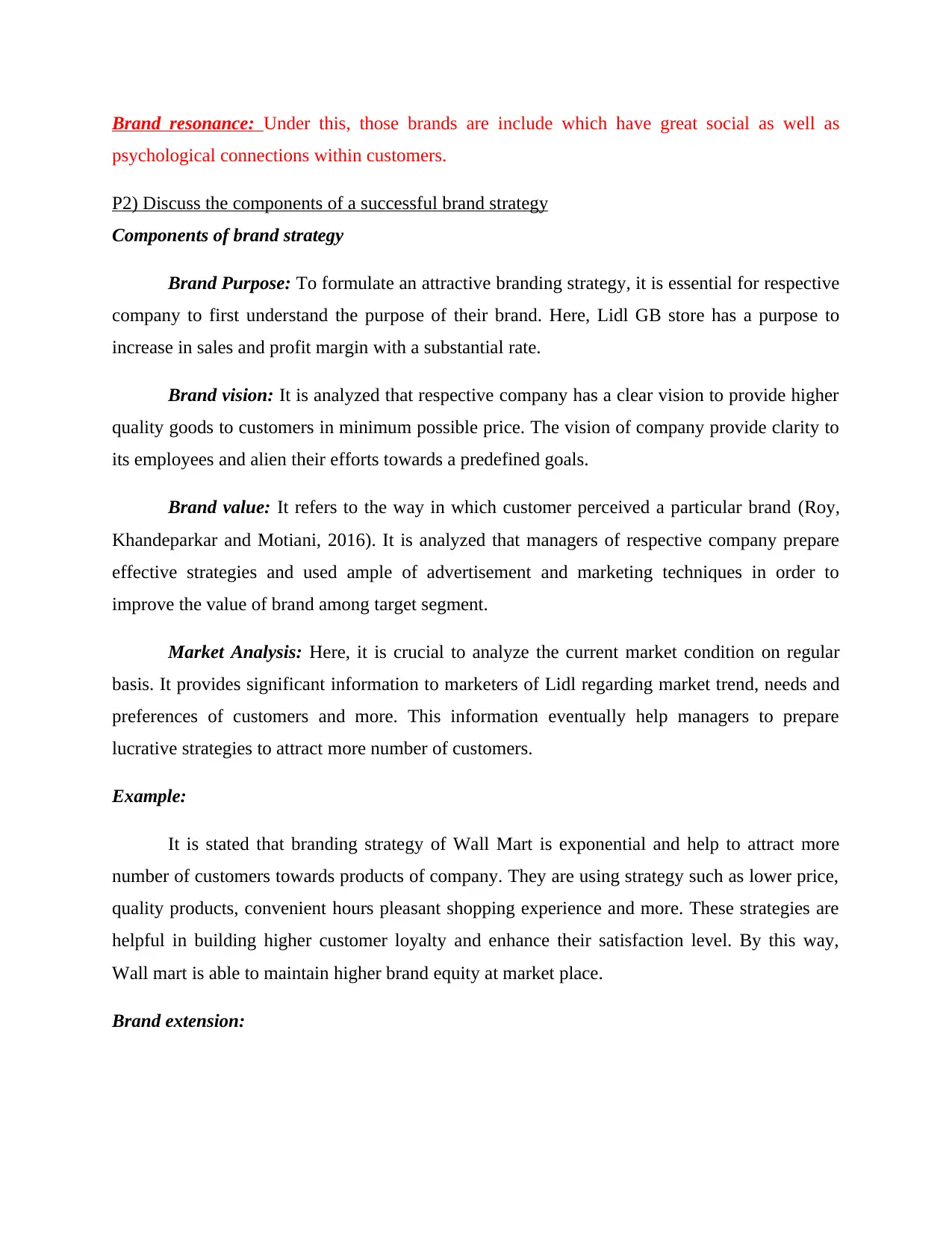
Brand resonance: Under this, those brands are include which have great social as well as
psychological connections within customers.
P2) Discuss the components of a successful brand strategy
Components of brand strategy
Brand Purpose: To formulate an attractive branding strategy, it is essential for respective
company to first understand the purpose of their brand. Here, Lidl GB store has a purpose to
increase in sales and profit margin with a substantial rate.
Brand vision: It is analyzed that respective company has a clear vision to provide higher
quality goods to customers in minimum possible price. The vision of company provide clarity to
its employees and alien their efforts towards a predefined goals.
Brand value: It refers to the way in which customer perceived a particular brand (Roy,
Khandeparkar and Motiani, 2016). It is analyzed that managers of respective company prepare
effective strategies and used ample of advertisement and marketing techniques in order to
improve the value of brand among target segment.
Market Analysis: Here, it is crucial to analyze the current market condition on regular
basis. It provides significant information to marketers of Lidl regarding market trend, needs and
preferences of customers and more. This information eventually help managers to prepare
lucrative strategies to attract more number of customers.
Example:
It is stated that branding strategy of Wall Mart is exponential and help to attract more
number of customers towards products of company. They are using strategy such as lower price,
quality products, convenient hours pleasant shopping experience and more. These strategies are
helpful in building higher customer loyalty and enhance their satisfaction level. By this way,
Wall mart is able to maintain higher brand equity at market place.
Brand extension:
psychological connections within customers.
P2) Discuss the components of a successful brand strategy
Components of brand strategy
Brand Purpose: To formulate an attractive branding strategy, it is essential for respective
company to first understand the purpose of their brand. Here, Lidl GB store has a purpose to
increase in sales and profit margin with a substantial rate.
Brand vision: It is analyzed that respective company has a clear vision to provide higher
quality goods to customers in minimum possible price. The vision of company provide clarity to
its employees and alien their efforts towards a predefined goals.
Brand value: It refers to the way in which customer perceived a particular brand (Roy,
Khandeparkar and Motiani, 2016). It is analyzed that managers of respective company prepare
effective strategies and used ample of advertisement and marketing techniques in order to
improve the value of brand among target segment.
Market Analysis: Here, it is crucial to analyze the current market condition on regular
basis. It provides significant information to marketers of Lidl regarding market trend, needs and
preferences of customers and more. This information eventually help managers to prepare
lucrative strategies to attract more number of customers.
Example:
It is stated that branding strategy of Wall Mart is exponential and help to attract more
number of customers towards products of company. They are using strategy such as lower price,
quality products, convenient hours pleasant shopping experience and more. These strategies are
helpful in building higher customer loyalty and enhance their satisfaction level. By this way,
Wall mart is able to maintain higher brand equity at market place.
Brand extension:
Paraphrase This Document
Need a fresh take? Get an instant paraphrase of this document with our AI Paraphraser
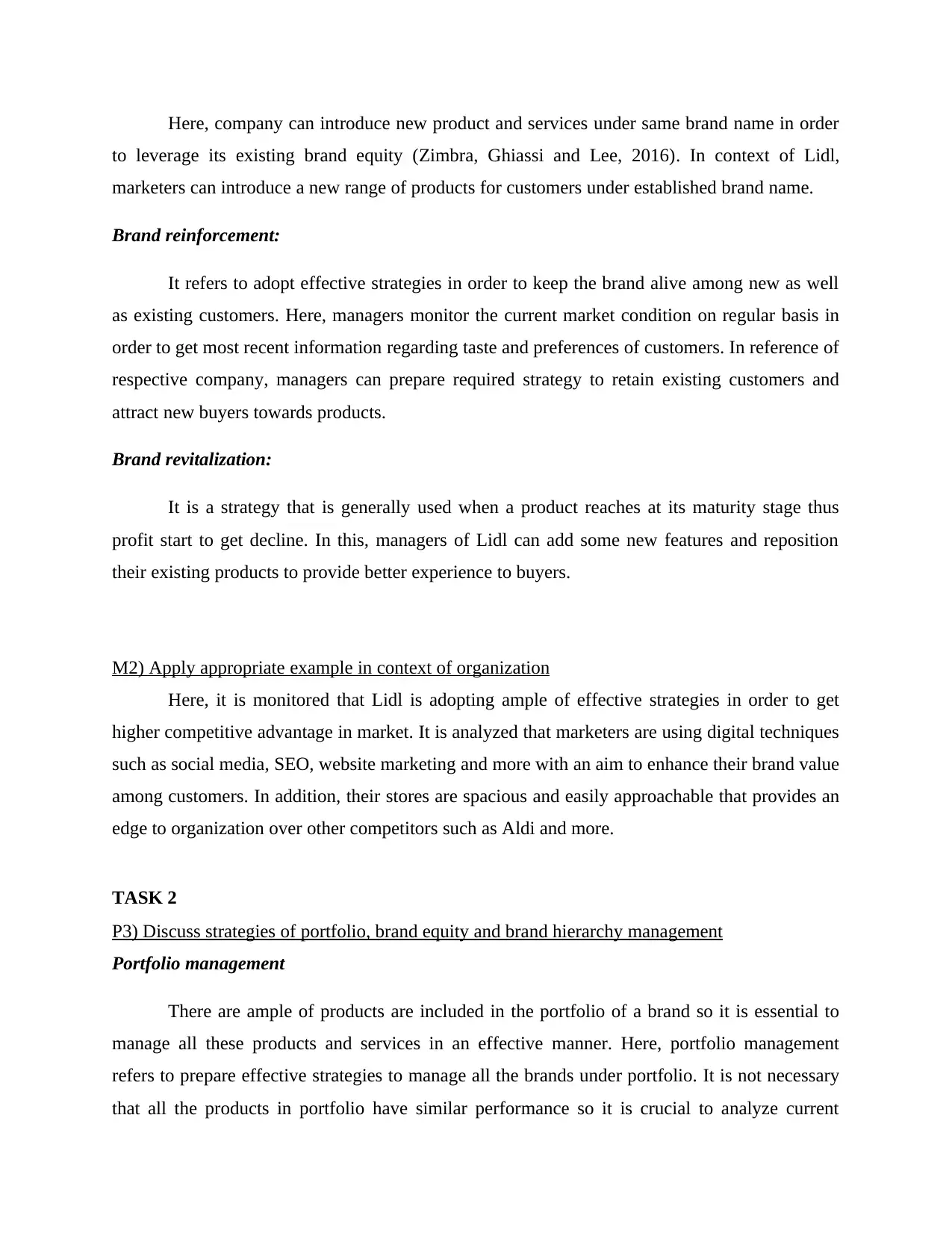
Here, company can introduce new product and services under same brand name in order
to leverage its existing brand equity (Zimbra, Ghiassi and Lee, 2016). In context of Lidl,
marketers can introduce a new range of products for customers under established brand name.
Brand reinforcement:
It refers to adopt effective strategies in order to keep the brand alive among new as well
as existing customers. Here, managers monitor the current market condition on regular basis in
order to get most recent information regarding taste and preferences of customers. In reference of
respective company, managers can prepare required strategy to retain existing customers and
attract new buyers towards products.
Brand revitalization:
It is a strategy that is generally used when a product reaches at its maturity stage thus
profit start to get decline. In this, managers of Lidl can add some new features and reposition
their existing products to provide better experience to buyers.
M2) Apply appropriate example in context of organization
Here, it is monitored that Lidl is adopting ample of effective strategies in order to get
higher competitive advantage in market. It is analyzed that marketers are using digital techniques
such as social media, SEO, website marketing and more with an aim to enhance their brand value
among customers. In addition, their stores are spacious and easily approachable that provides an
edge to organization over other competitors such as Aldi and more.
TASK 2
P3) Discuss strategies of portfolio, brand equity and brand hierarchy management
Portfolio management
There are ample of products are included in the portfolio of a brand so it is essential to
manage all these products and services in an effective manner. Here, portfolio management
refers to prepare effective strategies to manage all the brands under portfolio. It is not necessary
that all the products in portfolio have similar performance so it is crucial to analyze current
to leverage its existing brand equity (Zimbra, Ghiassi and Lee, 2016). In context of Lidl,
marketers can introduce a new range of products for customers under established brand name.
Brand reinforcement:
It refers to adopt effective strategies in order to keep the brand alive among new as well
as existing customers. Here, managers monitor the current market condition on regular basis in
order to get most recent information regarding taste and preferences of customers. In reference of
respective company, managers can prepare required strategy to retain existing customers and
attract new buyers towards products.
Brand revitalization:
It is a strategy that is generally used when a product reaches at its maturity stage thus
profit start to get decline. In this, managers of Lidl can add some new features and reposition
their existing products to provide better experience to buyers.
M2) Apply appropriate example in context of organization
Here, it is monitored that Lidl is adopting ample of effective strategies in order to get
higher competitive advantage in market. It is analyzed that marketers are using digital techniques
such as social media, SEO, website marketing and more with an aim to enhance their brand value
among customers. In addition, their stores are spacious and easily approachable that provides an
edge to organization over other competitors such as Aldi and more.
TASK 2
P3) Discuss strategies of portfolio, brand equity and brand hierarchy management
Portfolio management
There are ample of products are included in the portfolio of a brand so it is essential to
manage all these products and services in an effective manner. Here, portfolio management
refers to prepare effective strategies to manage all the brands under portfolio. It is not necessary
that all the products in portfolio have similar performance so it is crucial to analyze current
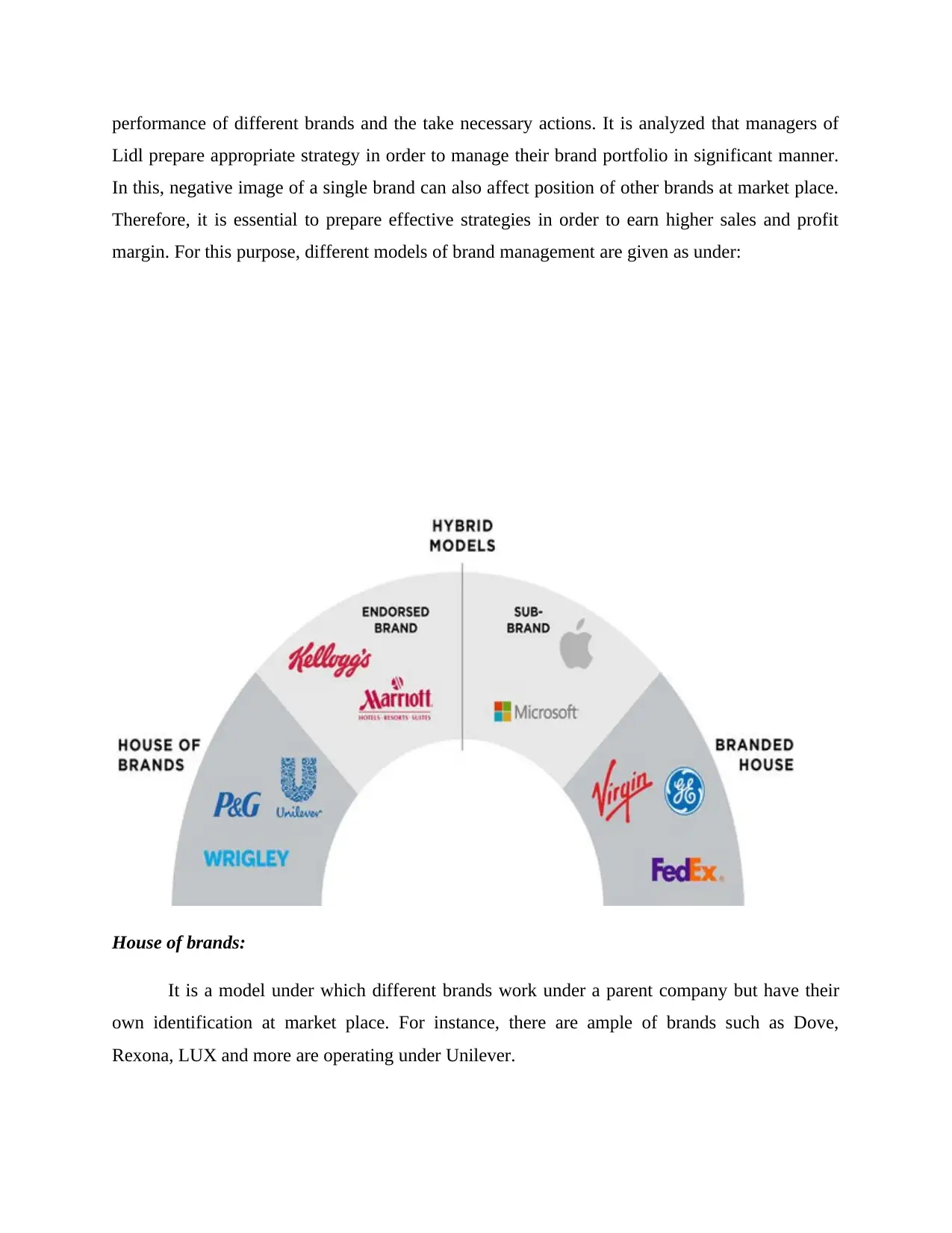
performance of different brands and the take necessary actions. It is analyzed that managers of
Lidl prepare appropriate strategy in order to manage their brand portfolio in significant manner.
In this, negative image of a single brand can also affect position of other brands at market place.
Therefore, it is essential to prepare effective strategies in order to earn higher sales and profit
margin. For this purpose, different models of brand management are given as under:
House of brands:
It is a model under which different brands work under a parent company but have their
own identification at market place. For instance, there are ample of brands such as Dove,
Rexona, LUX and more are operating under Unilever.
Lidl prepare appropriate strategy in order to manage their brand portfolio in significant manner.
In this, negative image of a single brand can also affect position of other brands at market place.
Therefore, it is essential to prepare effective strategies in order to earn higher sales and profit
margin. For this purpose, different models of brand management are given as under:
House of brands:
It is a model under which different brands work under a parent company but have their
own identification at market place. For instance, there are ample of brands such as Dove,
Rexona, LUX and more are operating under Unilever.
⊘ This is a preview!⊘
Do you want full access?
Subscribe today to unlock all pages.

Trusted by 1+ million students worldwide
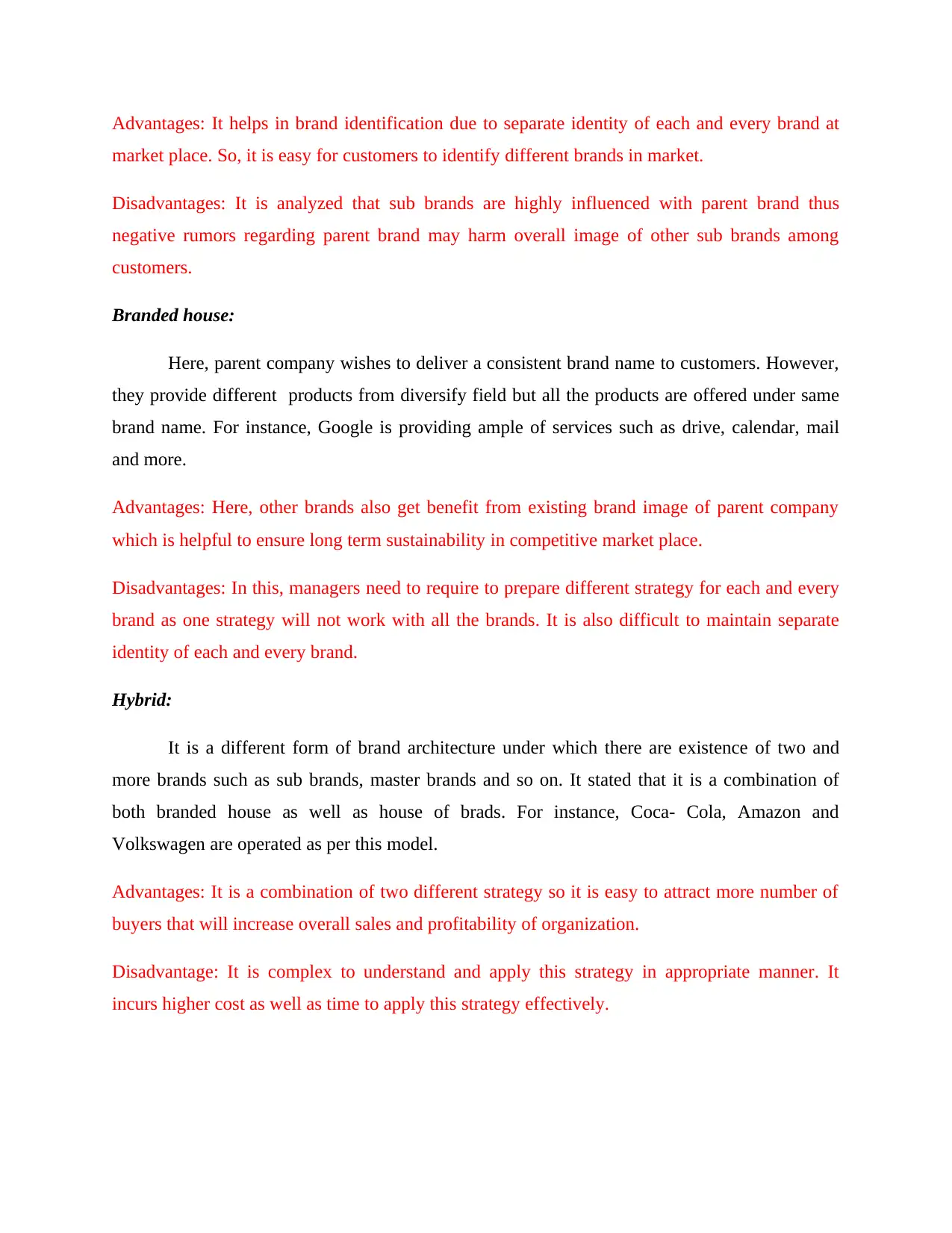
Advantages: It helps in brand identification due to separate identity of each and every brand at
market place. So, it is easy for customers to identify different brands in market.
Disadvantages: It is analyzed that sub brands are highly influenced with parent brand thus
negative rumors regarding parent brand may harm overall image of other sub brands among
customers.
Branded house:
Here, parent company wishes to deliver a consistent brand name to customers. However,
they provide different products from diversify field but all the products are offered under same
brand name. For instance, Google is providing ample of services such as drive, calendar, mail
and more.
Advantages: Here, other brands also get benefit from existing brand image of parent company
which is helpful to ensure long term sustainability in competitive market place.
Disadvantages: In this, managers need to require to prepare different strategy for each and every
brand as one strategy will not work with all the brands. It is also difficult to maintain separate
identity of each and every brand.
Hybrid:
It is a different form of brand architecture under which there are existence of two and
more brands such as sub brands, master brands and so on. It stated that it is a combination of
both branded house as well as house of brads. For instance, Coca- Cola, Amazon and
Volkswagen are operated as per this model.
Advantages: It is a combination of two different strategy so it is easy to attract more number of
buyers that will increase overall sales and profitability of organization.
Disadvantage: It is complex to understand and apply this strategy in appropriate manner. It
incurs higher cost as well as time to apply this strategy effectively.
market place. So, it is easy for customers to identify different brands in market.
Disadvantages: It is analyzed that sub brands are highly influenced with parent brand thus
negative rumors regarding parent brand may harm overall image of other sub brands among
customers.
Branded house:
Here, parent company wishes to deliver a consistent brand name to customers. However,
they provide different products from diversify field but all the products are offered under same
brand name. For instance, Google is providing ample of services such as drive, calendar, mail
and more.
Advantages: Here, other brands also get benefit from existing brand image of parent company
which is helpful to ensure long term sustainability in competitive market place.
Disadvantages: In this, managers need to require to prepare different strategy for each and every
brand as one strategy will not work with all the brands. It is also difficult to maintain separate
identity of each and every brand.
Hybrid:
It is a different form of brand architecture under which there are existence of two and
more brands such as sub brands, master brands and so on. It stated that it is a combination of
both branded house as well as house of brads. For instance, Coca- Cola, Amazon and
Volkswagen are operated as per this model.
Advantages: It is a combination of two different strategy so it is easy to attract more number of
buyers that will increase overall sales and profitability of organization.
Disadvantage: It is complex to understand and apply this strategy in appropriate manner. It
incurs higher cost as well as time to apply this strategy effectively.
Paraphrase This Document
Need a fresh take? Get an instant paraphrase of this document with our AI Paraphraser
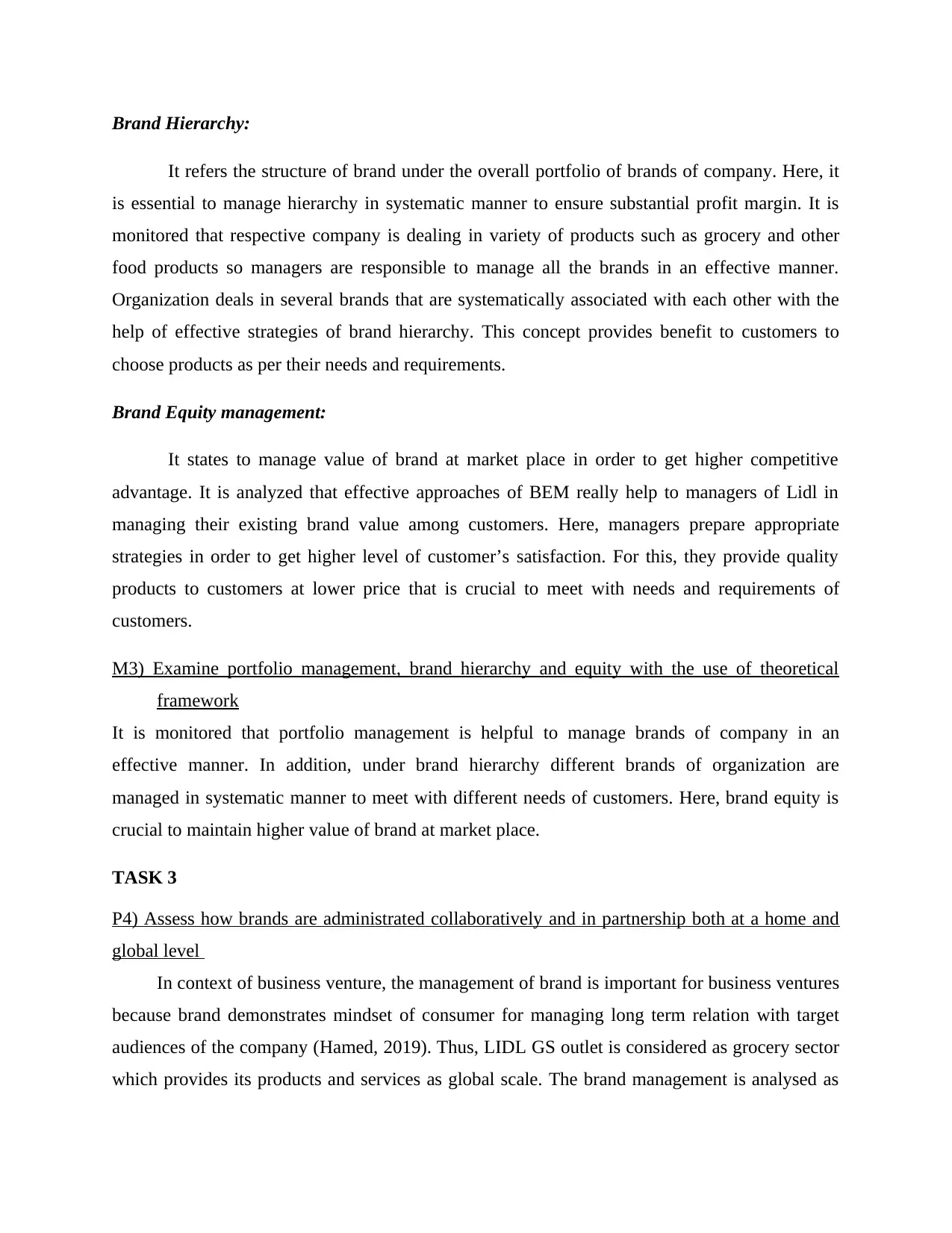
Brand Hierarchy:
It refers the structure of brand under the overall portfolio of brands of company. Here, it
is essential to manage hierarchy in systematic manner to ensure substantial profit margin. It is
monitored that respective company is dealing in variety of products such as grocery and other
food products so managers are responsible to manage all the brands in an effective manner.
Organization deals in several brands that are systematically associated with each other with the
help of effective strategies of brand hierarchy. This concept provides benefit to customers to
choose products as per their needs and requirements.
Brand Equity management:
It states to manage value of brand at market place in order to get higher competitive
advantage. It is analyzed that effective approaches of BEM really help to managers of Lidl in
managing their existing brand value among customers. Here, managers prepare appropriate
strategies in order to get higher level of customer’s satisfaction. For this, they provide quality
products to customers at lower price that is crucial to meet with needs and requirements of
customers.
M3) Examine portfolio management, brand hierarchy and equity with the use of theoretical
framework
It is monitored that portfolio management is helpful to manage brands of company in an
effective manner. In addition, under brand hierarchy different brands of organization are
managed in systematic manner to meet with different needs of customers. Here, brand equity is
crucial to maintain higher value of brand at market place.
TASK 3
P4) Assess how brands are administrated collaboratively and in partnership both at a home and
global level
In context of business venture, the management of brand is important for business ventures
because brand demonstrates mindset of consumer for managing long term relation with target
audiences of the company (Hamed, 2019). Thus, LIDL GS outlet is considered as grocery sector
which provides its products and services as global scale. The brand management is analysed as
It refers the structure of brand under the overall portfolio of brands of company. Here, it
is essential to manage hierarchy in systematic manner to ensure substantial profit margin. It is
monitored that respective company is dealing in variety of products such as grocery and other
food products so managers are responsible to manage all the brands in an effective manner.
Organization deals in several brands that are systematically associated with each other with the
help of effective strategies of brand hierarchy. This concept provides benefit to customers to
choose products as per their needs and requirements.
Brand Equity management:
It states to manage value of brand at market place in order to get higher competitive
advantage. It is analyzed that effective approaches of BEM really help to managers of Lidl in
managing their existing brand value among customers. Here, managers prepare appropriate
strategies in order to get higher level of customer’s satisfaction. For this, they provide quality
products to customers at lower price that is crucial to meet with needs and requirements of
customers.
M3) Examine portfolio management, brand hierarchy and equity with the use of theoretical
framework
It is monitored that portfolio management is helpful to manage brands of company in an
effective manner. In addition, under brand hierarchy different brands of organization are
managed in systematic manner to meet with different needs of customers. Here, brand equity is
crucial to maintain higher value of brand at market place.
TASK 3
P4) Assess how brands are administrated collaboratively and in partnership both at a home and
global level
In context of business venture, the management of brand is important for business ventures
because brand demonstrates mindset of consumer for managing long term relation with target
audiences of the company (Hamed, 2019). Thus, LIDL GS outlet is considered as grocery sector
which provides its products and services as global scale. The brand management is analysed as
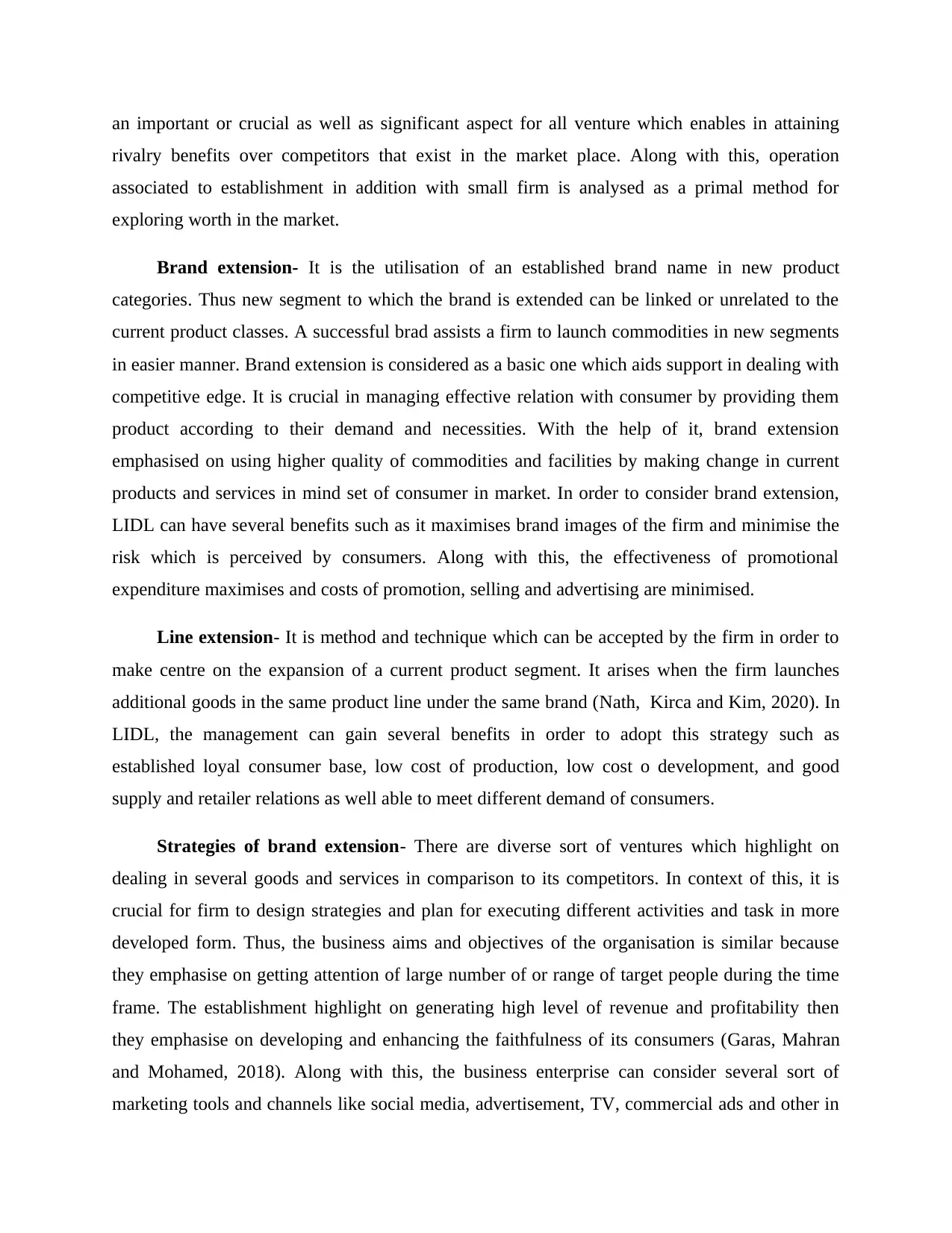
an important or crucial as well as significant aspect for all venture which enables in attaining
rivalry benefits over competitors that exist in the market place. Along with this, operation
associated to establishment in addition with small firm is analysed as a primal method for
exploring worth in the market.
Brand extension- It is the utilisation of an established brand name in new product
categories. Thus new segment to which the brand is extended can be linked or unrelated to the
current product classes. A successful brad assists a firm to launch commodities in new segments
in easier manner. Brand extension is considered as a basic one which aids support in dealing with
competitive edge. It is crucial in managing effective relation with consumer by providing them
product according to their demand and necessities. With the help of it, brand extension
emphasised on using higher quality of commodities and facilities by making change in current
products and services in mind set of consumer in market. In order to consider brand extension,
LIDL can have several benefits such as it maximises brand images of the firm and minimise the
risk which is perceived by consumers. Along with this, the effectiveness of promotional
expenditure maximises and costs of promotion, selling and advertising are minimised.
Line extension- It is method and technique which can be accepted by the firm in order to
make centre on the expansion of a current product segment. It arises when the firm launches
additional goods in the same product line under the same brand (Nath, Kirca and Kim, 2020). In
LIDL, the management can gain several benefits in order to adopt this strategy such as
established loyal consumer base, low cost of production, low cost o development, and good
supply and retailer relations as well able to meet different demand of consumers.
Strategies of brand extension- There are diverse sort of ventures which highlight on
dealing in several goods and services in comparison to its competitors. In context of this, it is
crucial for firm to design strategies and plan for executing different activities and task in more
developed form. Thus, the business aims and objectives of the organisation is similar because
they emphasise on getting attention of large number of or range of target people during the time
frame. The establishment highlight on generating high level of revenue and profitability then
they emphasise on developing and enhancing the faithfulness of its consumers (Garas, Mahran
and Mohamed, 2018). Along with this, the business enterprise can consider several sort of
marketing tools and channels like social media, advertisement, TV, commercial ads and other in
rivalry benefits over competitors that exist in the market place. Along with this, operation
associated to establishment in addition with small firm is analysed as a primal method for
exploring worth in the market.
Brand extension- It is the utilisation of an established brand name in new product
categories. Thus new segment to which the brand is extended can be linked or unrelated to the
current product classes. A successful brad assists a firm to launch commodities in new segments
in easier manner. Brand extension is considered as a basic one which aids support in dealing with
competitive edge. It is crucial in managing effective relation with consumer by providing them
product according to their demand and necessities. With the help of it, brand extension
emphasised on using higher quality of commodities and facilities by making change in current
products and services in mind set of consumer in market. In order to consider brand extension,
LIDL can have several benefits such as it maximises brand images of the firm and minimise the
risk which is perceived by consumers. Along with this, the effectiveness of promotional
expenditure maximises and costs of promotion, selling and advertising are minimised.
Line extension- It is method and technique which can be accepted by the firm in order to
make centre on the expansion of a current product segment. It arises when the firm launches
additional goods in the same product line under the same brand (Nath, Kirca and Kim, 2020). In
LIDL, the management can gain several benefits in order to adopt this strategy such as
established loyal consumer base, low cost of production, low cost o development, and good
supply and retailer relations as well able to meet different demand of consumers.
Strategies of brand extension- There are diverse sort of ventures which highlight on
dealing in several goods and services in comparison to its competitors. In context of this, it is
crucial for firm to design strategies and plan for executing different activities and task in more
developed form. Thus, the business aims and objectives of the organisation is similar because
they emphasise on getting attention of large number of or range of target people during the time
frame. The establishment highlight on generating high level of revenue and profitability then
they emphasise on developing and enhancing the faithfulness of its consumers (Garas, Mahran
and Mohamed, 2018). Along with this, the business enterprise can consider several sort of
marketing tools and channels like social media, advertisement, TV, commercial ads and other in
⊘ This is a preview!⊘
Do you want full access?
Subscribe today to unlock all pages.

Trusted by 1+ million students worldwide
1 out of 21
Related Documents
Your All-in-One AI-Powered Toolkit for Academic Success.
+13062052269
info@desklib.com
Available 24*7 on WhatsApp / Email
![[object Object]](/_next/static/media/star-bottom.7253800d.svg)
Unlock your academic potential
Copyright © 2020–2025 A2Z Services. All Rights Reserved. Developed and managed by ZUCOL.





